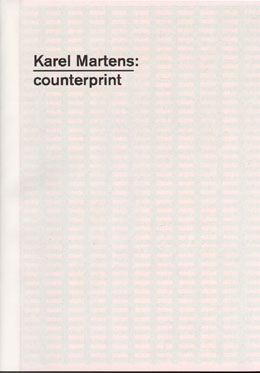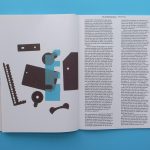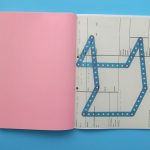Now that stocks of Karel Martens: printed matter are exhausted, we have published a short book that shows some of the uncommissioned printed work of Martens, with an essay on ‘The world as a printing surface’ by Elliman. This is very much an object-book, in which the work is not so much reproduced as bodied forth.
Contents
Introduction by Carel Kuitenbrouwer
[work by KM]
‘The world as a printing surface’ by Paul Elliman
Synopsis
Throughout his career as a designer, Karel Martens has made artistic (uncommissioned) work. In his early days he used sheets of paper, cut to make reliefs. Then he began to make prints from Meccano, metal plates and washers, and other found objects. These prints were made in very small numbers, or were perhaps one-offs. They were studies in form and colour, done as experiments or intended as gifts to friends. The work was very much in the Dutch tradition of experimental printing (the artist H.N.Werkman is the great exemplar here). But Martens kept this work largely apart from his graphic design work. He has occasionally shown it in exhibitions, and some pieces were published in the book Karel Martens: printed matter / drukwerk.
This is the first publication devoted to Martens’s prints. It is made in association with the printer Lecturis, in Eindhoven, and is produced to the highest quality. Bound in Chinese/Japanese fashion, like the first Martens book, it has a strong quality as an object. We are producing a limited number of copies (4,000) and will not reprint. The main text in the book is an essay by the English designer Paul Elliman: ‘The world as a printing surface’. Dutch critic and teacher Carel Kuitenbrouwer provides a short introduction. The book is designed by Hans Gremmen, under the supervision of Karel Martens, at the Werkplaats Typografie in Arnhem.
Reviews
Martens builds patterns from parts. He prints textures in time, moving his objects from place to place and capturing the traces in the image, ink by ink and layer by layer. These ‘moving’ pictures create abstraction from specific and rational shapes, while their color can be quiet or ‘sugary’ to the eye.
By studying the prints, you can pick out the blocks he builds on. These are small pleasures, but they emerge from close viewing, and ultimately the compositions are at once careful and graceful, subtle and vivid. This is refined craft with tools reinvented as toys: precision in play. In the end, these minutiae are mesmerizing.
Al Matthews, CNN Headline News, 16 August 2004






